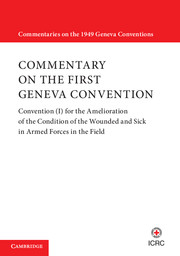 Commentary on the First Geneva Convention
Commentary on the First Geneva Convention Book contents
- Frontmatter
- Contents
- Foreword
- Acknowledgements
- Abbreviations
- Introduction
- Preamble
- Chapter I General provisions
- Article 1 Respect for the Convention
- Article 2 Application of the Convention
- Article 3 Conflicts not of an international character
- Article 4 Application by neutral Powers
- Article 5 Duration of application
- Article 6 Special agreements
- Article 7 Non-renunciation of rights
- Article 8 Protecting Powers
- Article 9 Activities of the ICRC and other impartial humanitarian organizations
- Article 10 Substitutes for Protecting Powers
- Article 11 Conciliation procedure
- Chapter II Wounded and sick
- Chapter III Medical units and establishments
- Chapter IV Personnel
- Chapter V Buildings and material
- Chapter VI Medical transports
- Chapter VII The distinctive emblem
- Chapter VIII Execution of the Convention
- Chapter IX Repression of abuses and infractions
- Final provisions
- Testimonium and signature clause
- Sources
- Index
- References
Article 3 - Conflicts not of an international character
from Chapter I - General provisions
Published online by Cambridge University Press: 06 January 2017
- Frontmatter
- Contents
- Foreword
- Acknowledgements
- Abbreviations
- Introduction
- Preamble
- Chapter I General provisions
- Article 1 Respect for the Convention
- Article 2 Application of the Convention
- Article 3 Conflicts not of an international character
- Article 4 Application by neutral Powers
- Article 5 Duration of application
- Article 6 Special agreements
- Article 7 Non-renunciation of rights
- Article 8 Protecting Powers
- Article 9 Activities of the ICRC and other impartial humanitarian organizations
- Article 10 Substitutes for Protecting Powers
- Article 11 Conciliation procedure
- Chapter II Wounded and sick
- Chapter III Medical units and establishments
- Chapter IV Personnel
- Chapter V Buildings and material
- Chapter VI Medical transports
- Chapter VII The distinctive emblem
- Chapter VIII Execution of the Convention
- Chapter IX Repression of abuses and infractions
- Final provisions
- Testimonium and signature clause
- Sources
- Index
- References
- Type
- Chapter
- Information
- Commentary on the First Geneva ConventionConvention (I) for the Amelioration of the Condition of the Wounded and Sick in Armed Forces in the Field, pp. 126 - 325Publisher: Cambridge University PressPrint publication year: 2016
References
- 2
- Cited by


